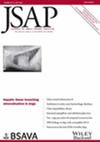Concurrent anomalies are often found in nasopharyngeal stenosis and choanal atresia; some seem to be of primary nature, whereas others may be coincidental. This study aimed to report the computed tomography features and related comorbidities of these diseases.
A cross-sectional retrospective study was performed using case and control groups defined according to the presence of signs of upper airway disease and the presence/absence of nasopharyngeal stenosis, respectively. The inclusion criteria were full-head tomography scans and access to clinical records. The exclusion criteria were brachycephalic breed, head trauma and neoplasm. Clinical and computed tomographic findings and relevant comorbidities were recorded.
Forty-three cats were included, 23 cases and 20 controls. The case group was significantly younger, had more paranasal sinus anomalies and never had turbinate lysis, also, had significantly more soft palate anomalies, which was significantly shorter. Nasopharyngeal stenosis varied from membrane appearance to partial or complete adhesion of the soft palate to the nasopharynx, was mainly located in the caudal region of the nasopharynx and was imperforated in approximately half of the cases. Imperforated membranes were significantly thicker in the sagittal plane and were significantly associated with nasal obstruction and soft tissue attenuation of the tympanic bulla. Hiatal hernia and ventricular asymmetry were only encountered in three and two cases, respectively, with nasopharyngeal stenosis.
Computed tomography in cats with nasopharyngeal stenosis can identify concurrent anomalies, can help to differentiate a possible choanal atresia and evaluate the magnitude of its significance.


